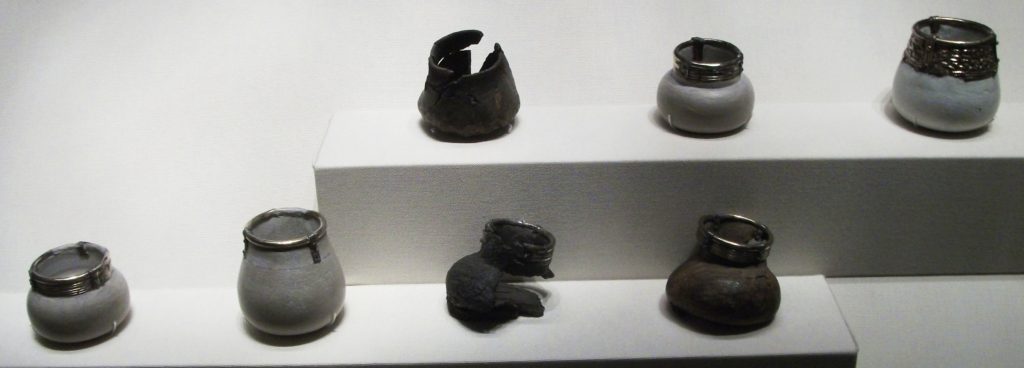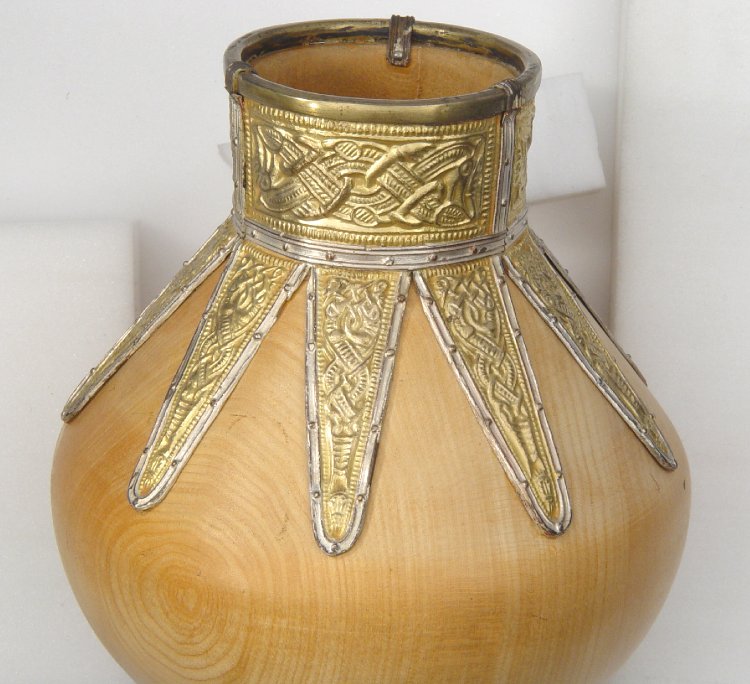In researching more about medieval drinking vessels, I’ve backed into a thorny issue: what, exactly, was beor/bjorr, as written about in various Scandinavian and Anglo-Saxon sources?
The Background
I’ve been looking at more old drinking vessels, with the intent of trying to reproduce them for my Etsy shop. Again, with some of them, I was struck by their size–specifically, how oddly small many of them are. I have previously mentioned the Jelling Cup, at two inches in height. There are also “Sutton Hoo bottles” (pictured below). They also clock in at two inches or less.

Even the somewhat larger bottles from Sutton Hoo are “only” five or so inches:
There was commentary online to the effect that whatever they were drinking from these vessels, it was likely strong. But what, pray tell, was it?
Strong Drink
A minute or two of playing with Google led me to a mention of there being debate in academic circles as to the nature of a particular “Viking drink,” generally described as strong, sweet, and rarer/more valuable than other drinks.
I’ll spare the entirety of the argument (one of the most cogent discussions I’ve found is this paper, by Christine Fell); in short, most sources we have in Old Norse and Anglo-Saxon describe four types of alcoholic drink: win (wine), mjod (mead), ealu (ale), and beor/bjorr. What is beor? Most modern translations take the easy way out, and gloss it to beer, but that doesn’t seem right.
These writings are, almost without exception, from before the ale/beer distinction came about. (These are texts from before 1200AD; the English didn’t start differentiating until the 1400’s or so.) Pretty much everything at the time would have been what we’d classify as “ale.”
Also, a good case can be made that beor wasn’t grain-based, which again rules out beer. So, it’s not wine, it’s not mead, it’s not ale, and it’s not beer… What could it be? A plausible hypothesis is cider–or, at least, something cider-like. Apparently, in Normandy the word “bere” is used for cider. Depending on the provenance of the word, there’s a certain something there.
Beor’s Not Quite Cider
But even going with cider, some hurdles appear. Anglo-Saxon, at least, has a term for cider (aepplewin). And beor appears to have been sweetened (read Fell’s tract, above, for the reasoning). Perhaps a backsweetened cider? Again, plausible…
I certainly don’t claim to have the answers–I’ve only been devoting a little spare time to the topic for the last several days, really. I’m fine with it being a “strong, backsweetened fermented juice drink,” as far as that gets us. A thought did strike me that they could have “jacked” (freeze-distilled) a fruit drink, then sweetened it with honey to make it more palatable. I’m tempted to say we’d have some description somewhere of the process, though, and we don’t.
So where does that leave us? As with so many things involved in period brewing, with more questions than answers. What are your thoughts on beor, readers? Let’s discuss them in the comments1
